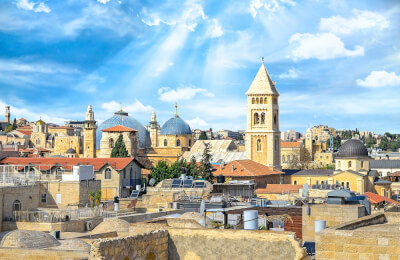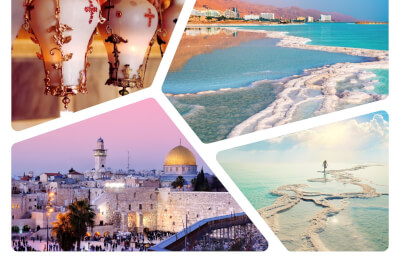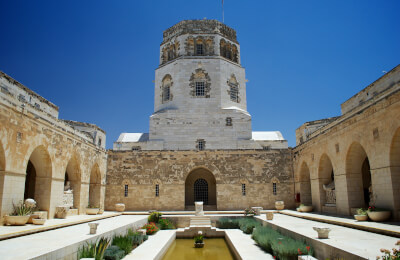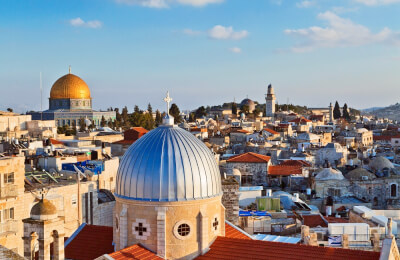
42. Walking Jerusalem Promotion
1. Christian Jerusalem Promotion

2. Jerusalem of three religions Promotion
4. Jerusalem Underground Promotion
5. Bethlehem and Christian Jerusalem Promotion
157. Masons in Jerusalem Promotion
136. Jerusalem - Via Dolorosa Promotion
121. Bulgakov and Jerusalem Promotion
We also found excursions from other cities that are close to your departure city
Other excursions that also deserve your attention
Jerusalem, one of the oldest cities in the world, holds a profound narrative that has shaped the spiritual and historical landscape of countless generations. The heart of this ancient city is the Old Town, a place where every alleyway and stone whispers tales of the past, where different cultures, religions, and historical periods are intertwined in an intricate tapestry. This 0.9 square kilometer area, enclosed by majestic walls, is more than just a step back into history; it's a leap into a world that has shaped much of the globe's religious and cultural foundation.
**The Timeless Quadrants of History**
The Old Town of Jerusalem is divided into four distinct quarters: the Armenian Quarter, the Jewish Quarter, the Christian Quarter, and the Muslim Quarter. This division, established in the 19th century, is a living representation of Jerusalem's multifaceted identity.
The **Armenian Quarter** is the smallest among the four and represents a rich Armenian heritage. Interesting fact: it's considered a separate monastic enclave, where the St. James Monastery, a stunning 12th-century structure, stands in testimony to centuries of devotion and tradition. The presence of Armenians in Jerusalem dates back to the 4th century, making it one of the oldest Armenian diasporas in the world.
The **Jewish Quarter** is a testament to the endurance of the Jewish people and their historical and spiritual connection to Jerusalem. The restored Hurva Synagogue, with its impressive arch, symbolizes Jewish resilience as it was destroyed and rebuilt multiple times throughout history. Beneath the present-day quarter lie the extensive ruins of ancient Jerusalem, adding layers of historical significance.
The **Christian Quarter** is home to the holiest sites in Christianity, including the Church of the Holy Sepulchre, believed by many to be the place of Jesus's crucifixion, burial, and resurrection. Thousands of pilgrims from around the world walk the Via Dolorosa, following Jesus's footsteps on the path to crucifixion, making it a profound spiritual journey for believers.
The **Muslim Quarter** is the largest and most populous, bustling with vibrant markets (souks) and home to significant sites such as the Pool of Bethesda. It's a place where Islamic heritage thrives amidst the daily prayers echoing from the minarets, reinforcing the Islamic connection to the city since Umar ibn Al-Khattab, the second caliph, entered Jerusalem in 637 AD.
**Embracing Sacred Foundations: The Western Wall and The Dome of the Rock**
Within the Jewish Quarter lies the Western Wall, a remnant of the Second Jewish Temple, destroyed in 70 AD. This site, also known as the "Wailing Wall," is the closest accessible prayer site to the original Holy of Holies and thus the most sacred place for Jews to pray. Visitors are struck by the sight of devout prayers inserted into the wall's crevices, representing the hopes and prayers of millions from around the globe.
Adjacent to the Jewish holy site, on the Temple Mount, stands the resplendent Dome of the Rock, an Islamic masterpiece from the 7th century and one of the city’s most recognizable landmarks. It's believed to be the site where the Prophet Muhammad ascended to heaven during the Isra and Mi'raj. The rock beneath the dome is also significant for Jews, as it's traditionally associated with the place where Abraham prepared to sacrifice his son Isaac. This site's shared significance adds to the rich complexity of Jerusalem's sacred geography.
**A Melting Pot of Cultures**
Despite the division into quarters, the Old Town thrives on its diversity. The air is filled with the scent of spices from local cuisines, the sounds of different languages, and the call to prayer from minarets, interspersed with church bells. Marketplaces in the Muslim Quarter, such as the Khan el-Zeit, the main market street, are packed with a variety of goods, from exotic fruits to handcrafted jewelry, reflecting the region's trade and cultural exchange across centuries.
In the Christian Quarter, the Church of the Holy Sepulchre is not only a central religious establishment but also a symbol of global Christian unity and diversity. Different denominations, including the Greek Orthodox, Roman Catholic, and Armenian Apostolic churches, share custody of the church, making it a unique place where various Christian traditions converge.
**Preservation of Heritage: A Continuous Journey**
The Old Town of Jerusalem is a UNESCO World Heritage site, recognized for its deep spiritual meaning and cultural heritage. However, its status as a heritage site comes with challenges. Preservation efforts are constant, as this historical masterpiece requires maintenance and restoration, all while balancing the needs of its inhabitants and millions of pilgrims and tourists. The preservation of archaeological sites, religious establishments, and residential areas is a delicate task, often accompanied by diplomatic efforts due to the city's complex political situation.
**Festivals and Events: Celebrating Life in the Old City**
Life in the Old Town is marked by numerous religious and cultural festivities. Events such as the Jewish celebration of Purim, the Christian Holy Week, and the Islamic observances of Ramadan bring the city to life, reflecting its religious mosaic. Moreover, cultural events like the Jerusalem Festival of Light transform the city's nightscape with dazzling light installations, showcasing contemporary artistic expressions amidst ancient architecture.
**The Citadel: Witness to Time**
The Tower of David, or the Jerusalem Citadel, is a historical edifice that cannot be missed. With its archaeological remains dating back over 2,700 years, the citadel serves as a comprehensive museum, narrating Jerusalem's story from its ancient beginnings to modern times. The tower itself provides a panoramic view of the Old Town and the areas beyond, symbolizing the city's enduring presence through the ages.
**Conclusion: Walking Through Living History**
To wander through the narrow, winding streets of Jerusalem's Old Town is to walk through a living history book. Every cobblestone and corner has witnessed centuries of human civilization, from kings and prophets to soldiers and pilgrims. The city is a living testament to the human spirit's resilience, faith, and unending quest for the divine.
The
Old Town of Jerusalem teaches profound respect for diversity, where mosques, synagogues, and churches stand side by side, their stones weathered by time, conflict, and reconciliation. It's a place where history and prophecy, human hardship, and divine spirituality are intricately woven together, creating a tapestry unmatched by any other place in the world. In Jerusalem, the past is never simply history; it's a legacy that shapes the present and the future, a city on a hill that, despite its age, never ceases to captivate the human heart.



















